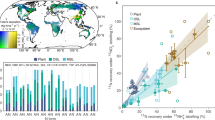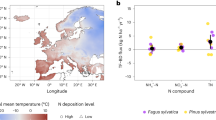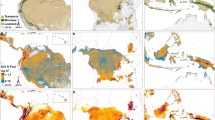Abstract
Humans have altered global nitrogen cycling such that more atmospheric N2 is being converted (‘fixed’) into biologically reactive forms by anthropogenic activities than by all natural processes combined1. In particular, nitrogen oxides emitted during fuel combustion and ammonia volatilized as a result of intensive agriculture have increased atmospheric nitrogen inputs (mostly NO3 and NH4) to temperate forests in the Northern Hemisphere2,3,4. Because tree growth in northern temperate regions is typically nitrogen-limited5, increased nitrogen deposition could have the effect of attenuating rising atmospheric CO2 by stimulating the accumulation of forest biomass. Forest inventories indicate that the carbon contents of northern forests have increased concurrently with nitrogen deposition since the 1950s6,7,8. In addition, variations in atmospheric CO2 indicate a globally significant carbon sink in northern mid-latitude forest regions9,10,11,12. It is unclear, however, whether elevated nitrogen deposition or other factors are the primary cause of carbon sequestration in northern forests. Here we use evidence from 15N-tracer studies in nine forests to show that elevated nitrogen deposition is unlikely to be a major contributor to the putative CO2 sink in forested northern temperature regions.
This is a preview of subscription content, access via your institution
Access options
Subscribe to this journal
Receive 51 print issues and online access
$199.00 per year
only $3.90 per issue
Buy this article
- Purchase on Springer Link
- Instant access to full article PDF
Prices may be subject to local taxes which are calculated during checkout

Similar content being viewed by others
References
Vitousek, P. M. et al. Human alteration of the global nitrogen cycle: sources and consequences. Ecol. Appl. 7, 737–750 (1997).
Galloway, J. N., Schlesinger, W. H., Levy H. II, Michaels, A. & Schnoor, J. L. Nitrogen fixation: anthropogenic enhancement-environmental response. Glob. Biogeochem. Cycles 9, 235–252 (1995).
Townsend, A. R., Braswell, B. H., Holland, E. A. & Penner, J. E. Spatial and temporal patterns in terrestrial carbon storage due to deposition of fossil fuel nitrogen. Ecol. Appl. 6, 806–814 (1996).
Holland, E. A. Variations in the predicted spatial distribution of atmospheric nitrogen deposition and their impact on carbon uptake by terrestrial ecosystems. J. Geophys Res. 102, 15849–15866 (1997).
Vitousek, P. M. & Howarth, R. W. Nitrogen limitation on land and in the sea: How can it occur? Biogeochemistry 13, 87–115 (1991).
Speicker, H., Mielikäinen, K., Köhl, M. & Skovsgaard, J. P. (eds) Growth Trends in European Forests (Springer, Berlin, 1996).
Apps, M. J. & Kurz, W. A. in Carbon Balance of World's Forested Ecosystem Towards a Global Assessment (ed. Kanninen, M.) (Acad. of Finland, Helsinki, 1994).
Turner, D. P., Koerper, G. J., Harmon, M. E. & Lee, J. J. Acarbon budget for forests of the conterminous United States. Ecol. Appl. 5, 421–436 (1995).
Tans, P. P., Fung, I. Y. & Enting, I. G. in Biotic Feedbacks in the Global Climate System: Will the Warming Feed the Warming (eds Woodwell, G. M. & Mackenzie, F. T.) (Oxford Univ. Press, New York, 1994).
Ciais, P. et al. Partitioning of ocean and land uptake of CO2 as inferred by δ13C measurements from the NOAA Climate Monitoring and Diagnostics Laboratory global air sampling network. J. Geophys. Res. 100, 5051–5070 (1995).
Schimel, D. S. Terrestrial ecosystems and the carbon cycle. Glob. Change Biol. 1, 77–91 (1995).
Houghton, R. A., Davidson, E. A. & Woodwell, G. M. Missing sinks, feedbacks, and understanding the role of terrestrial ecosystems in the global carbon balance. Glob. Biogeochem. Cycles 12, 25–34 (1998).
Kohlmaier, G. H., Janecek, A. & Plochl, M. in Advances in Enrionmental Modelling. Marani, A.) 207–234 (Elsevier, New York, 1998).
Hudson, J. J. M., Gherini, S. A. & Goldstein, R. A. Modeling the global carbon cycle: nitrogen fertilization of the terrestrial biosphere and the “missing” CO2 sink. Glob. Biogeochem. Cycles 8, 307–333 (1994).
Mäkipää, R. Effect of nitrogen input on carbon accumulation of boreal forest soils and ground vegetation. Forest Ecol. Mgmt 79, 217–226 (1995).
Peterson, B. J. & Melillo, J. M. The potential storage of carbon caused by eutrophication of the biosphere. Tellus 37B, 117–127 (1985).
Schindler, D. W. & Bayley, S. E. The biosphere as an increasing sink for atmospheric carbon: estimates from increased nitrogen deposition. Glob. Biogeochem. Cycles 7, 717–733 (1993).
Rastetter, E. B., McKane, R. B., Shaver, G. R. & Melillo, J. M. Changes in C storage by terrestrial ecosystems: how C–N interactions restrict responses to CO2 and temperature. Wat. Air Soil Pollut. 64, 327–344 (1992).
Tietema, A., Emmett, B. A., Gundersen, P., Kjønaas, O. J. & Koopmans, C. The fate of 15N-labelled nitrogen deposition in coniferous forest ecosystems. Forest Ecol. Mgmt 101, 19–27 (1998).
Schleppi, P. et al. Simulation of increased nitrogen deposition to a montane forest ecosystem: partitioning of the added 15N. Wat. Air Soil Pollut.(in the press).
Nadelhoffer, K. J. et al. The fate of 15N-labelled nitrate additions to a northern hardwood forest in eastern Maine, USA. Oceologia 103, 292–301 (1995).
Nadelhoffer, K. J., Downs, M. R., Fry, B., Magill, A. & Aber, J. D. Controls on N retention and exports in a fertilized watershed. Environ. Monitor. Assess.(in the press).
Nadelhoffer, K. J., Downs, M. R. & Fry, B. Sinks for N additions to an oak forest and a red pine plantation at the Harvard Forest, Massachusetts, USA. Ecol. Appl. 9, 72–86 (1999).
Emmett, B. A. et al. Predicting the effects of atmospheric nitrogen deposition on conifer stands: evidence from the NITREX ecosystem-scale experiments. Ecosystems 1, 352–360 (1998).
Magill, A. H., Downs, M. R., Nadelhoffer, K. J., Hallett, R. A. & Aber, J. D. Forest ecosystem response to four years of chronic nitrate and sulfate additions at Bear Brooks Watershed, Maine, USA. Forest Ecol. Mgmt 84, 29–37 (1996).
Magill, A. H. et al. Biogeochemical response of forest ecosystems to simulated chronic nitrogen deposition. Ecol. Appl. 7, 402–415 (1997).
McNulty, S. G., Aber, J. D. & Boone, R. D. Spatial changes in forest floor and foliar chemistry of spruce-fir forests across central New England. Biogeochemistry 14, 13–29 (1991).
Gundersen, P., Callesen, I. & de Vries, W. Nitrate leaching in forest ecosystems is related to forest floor C/N ratios. Environ. Pollut. 102, 403–407 (1998).
Abrahamsen, G., Stuanes, A. & Tveite, B. Long-Term Experiments with Acid Rain in Norwegian Forest Ecosystems. Ecological Studies Vol. 104(Springer, New York, 1993).
Hauck, R. D., Meisinger, J. J. & Mulvaney, R. L. in Methods of Soil Analysis, Part 2: Microbiological and Chemical Properties (eds Weaver, R. W., Angle, J. S. & Bottomly, J. S.) (Soil Science Society of America, Madison, WI, 1994).
Acknowledgements
This research was funded in part by the Commission of European Communities NITREX Project, the US National Science Foundation and the US–Norway Fulbright Program.
Author information
Authors and Affiliations
Corresponding author
Rights and permissions
About this article
Cite this article
Nadelhoffer, K., Emmett, B., Gundersen, P. et al. Nitrogen deposition makes a minor contribution to carbon sequestration in temperate forests. Nature 398, 145–148 (1999). https://doi.org/10.1038/18205
Received:
Accepted:
Issue Date:
DOI: https://doi.org/10.1038/18205
This article is cited by
-
Mycorrhizal type regulates trade-offs between plant and soil carbon in forests
Nature Climate Change (2024)
-
Nitrogen deposition mediates more stochastic processes in structuring plant community than soil microbial community in the Eurasian steppe
Science China Life Sciences (2024)
-
Nitrogen mineralization in the oldest climax communities in the eastern Mediterranean region
Journal of Forestry Research (2024)
-
Integrating carbon sequestration and biodiversity impacts in forested ecosystems: Concepts, cases, and policies
Ambio (2023)
-
Assessment and current dynamics of nutrients with reference to nitrogen attributes in subalpine forests of Western Himalaya, India
Environmental Monitoring and Assessment (2022)
Comments
By submitting a comment you agree to abide by our Terms and Community Guidelines. If you find something abusive or that does not comply with our terms or guidelines please flag it as inappropriate.



